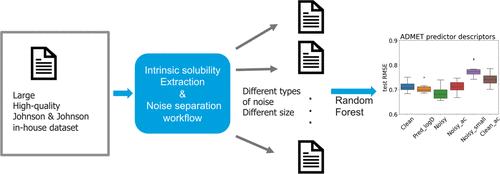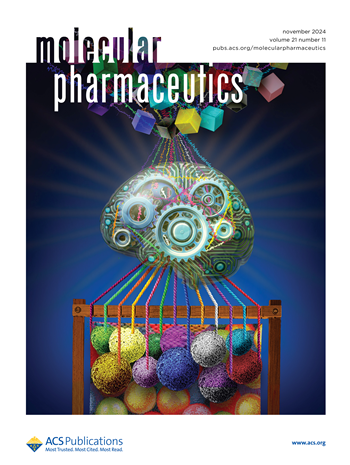Effect of Data Quality and Data Quantity on the Estimation of Intrinsic Solubility: Analysis Based on a Single-Source Data Set
IF 4.5
2区 医学
Q2 MEDICINE, RESEARCH & EXPERIMENTAL
引用次数: 0
Abstract
Aqueous solubility is one of the most important physicochemical properties of drug molecules and a major driving force for oral drug absorption. To date, the performance of in silico models for the estimation of solubility for novel chemical space is limited. To investigate possible reasons and remedies for this, the Johnson and Johnson in-house aqueous solubility data with over 40,000 compounds was leveraged. All data were generated through the same high-throughput assay, providing a unique opportunity to explore the relationship between data quality, quantity, and model estimations. Six intrinsic solubility data sets with different sizes and noise levels were generated by making use of three different approaches: (i) inclusion or exclusion of amorphous solid residue, (ii) measured or experimental log D to identify the intrinsic solubility, and (iii) adopting or omitting a quality check process in the data processing workflow. A random forest regressor was trained on the data sets with three different sets of descriptors calculated from RDKit, ADMET predictor, or Mordred, and the performances were evaluated with nested cross-validation as well as ten refined test sets. The models confirm, as expected, that with the same data set size, high-quality data leads to better model performance; however, also, models trained with larger data sets containing analytical variability can give equally accurate estimations compared to models trained with small, clean, and diverse data sets. However, noise introduced by including the presence of amorphous solid postsolubility measurement in the training data set cannot be overcome by increasing data size, as they are introducing a biased systematic positive error in the data set, confirming the importance of critical data review. Finally, two top-performing models were tested on the first test set from the second solubility challenge, achieving RMSE values of 0.74 and 0.72 and log S ± 0.5 of 46 and 48%, respectively. These results demonstrated improved performance compared to those reported in the findings of the competition, highlighting that a single-source curated data set can enhance the prediction of intrinsic solubility.

数据质量和数据数量对估算内在溶解度的影响:基于单一来源数据集的分析
水溶性是药物分子最重要的理化性质之一,也是口服药物吸收的主要驱动力。迄今为止,用于估算新型化学空间溶解度的硅学模型性能有限。为了研究造成这种情况的可能原因和补救措施,我们利用了强生公司内部超过 40,000 种化合物的水溶性数据。所有数据均通过相同的高通量试验生成,为探索数据质量、数量和模型估算之间的关系提供了独特的机会。利用三种不同的方法生成了六组具有不同大小和噪声水平的本征溶解度数据集:(i) 加入或排除无定形固体残留物;(ii) 用测量或实验对数 D 来确定本征溶解度;(iii) 在数据处理工作流程中采用或省略质量检查过程。使用从 RDKit、ADMET 预测器或 Mordred 计算出的三组不同描述符对数据集进行了随机森林回归训练,并通过嵌套交叉验证和 10 个精炼测试集对其性能进行了评估。这些模型证实,正如预期的那样,在数据集大小相同的情况下,高质量的数据能带来更好的模型性能;不过,与使用小型、干净和多样化数据集训练的模型相比,使用含有分析变异的较大数据集训练的模型也能提供同样准确的估计。然而,在训练数据集中加入非晶态固体溶解后测量所带来的噪声并不能通过增加数据量来克服,因为它们在数据集中引入了有偏差的系统性正误差,这证实了关键数据审查的重要性。最后,在第二次溶解度挑战赛的第一个测试集上测试了两个表现最佳的模型,其 RMSE 值分别为 0.74 和 0.72,log S ± 0.5 分别为 46% 和 48%。这些结果表明,与竞赛结果中报告的结果相比,这些模型的性能有所提高,突出表明单一来源的数据集可以提高内在溶解度的预测能力。
本文章由计算机程序翻译,如有差异,请以英文原文为准。
求助全文
约1分钟内获得全文
求助全文
来源期刊

Molecular Pharmaceutics
医学-药学
CiteScore
8.00
自引率
6.10%
发文量
391
审稿时长
2 months
期刊介绍:
Molecular Pharmaceutics publishes the results of original research that contributes significantly to the molecular mechanistic understanding of drug delivery and drug delivery systems. The journal encourages contributions describing research at the interface of drug discovery and drug development.
Scientific areas within the scope of the journal include physical and pharmaceutical chemistry, biochemistry and biophysics, molecular and cellular biology, and polymer and materials science as they relate to drug and drug delivery system efficacy. Mechanistic Drug Delivery and Drug Targeting research on modulating activity and efficacy of a drug or drug product is within the scope of Molecular Pharmaceutics. Theoretical and experimental peer-reviewed research articles, communications, reviews, and perspectives are welcomed.
 求助内容:
求助内容: 应助结果提醒方式:
应助结果提醒方式:


